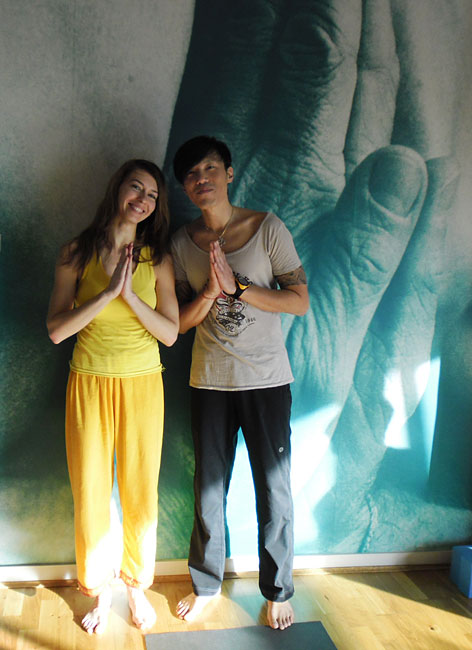Yoga dictionary. Vritti
 More often than not, the mind is either in a state of experiencing the past or planning for the future. This forces a person to experience many times again the suffering already experienced in the past, or to worry about their future. All these actions of the mind are due to its fluctuation. The Yoga sutras of Patanjali deal with the concept of Vritti.
More often than not, the mind is either in a state of experiencing the past or planning for the future. This forces a person to experience many times again the suffering already experienced in the past, or to worry about their future. All these actions of the mind are due to its fluctuation. The Yoga sutras of Patanjali deal with the concept of Vritti.
Translated from Sanskrit “Vritti” means ‘excitement’, ‘hesitation’. A comparison may be made with a pond whose water is at rest. And in this case, it reflects the Moon. By the Moon one can understand objective reality, which, provided the mind is calm, is reflected in it without distortion. When the water begins to be affected by the wind, it begins to fluctuate, and the reflection of the moon becomes distorted. The water in the pond is the mind of the living entity, and by the wind one can mean just Vritti — its vibrations. And under the influence of Vritti, the mind begins to distort objective reality. That is the danger of such a thing as Vritti. In his treatise, Patanjali described getting rid of it as the goal of yoga. This is stated in Sutra 2, Chapter 1. In Svensson’s translation, the Sutra reads: “Yoga is the control of the disturbances inherent in the mind.”
For some reason there is Vritti? The variety of vrittis is immeasurable because it is conditioned by the karma of a particular person, so everyone has his own set of vrittis. The emergence of these fluctuations is due to samskar — karmic “prints” created by past actions, and vasan — habits, inclinations to certain behaviors. The Samskaras and Vasanas are stored in the mind of the living entity, and when one or another karma Matures, they begin to affect the mind, and thus the Vritti — vibrations of the mind arise.
Patanjali describes how to eliminate Vritti in Sutra 12 of the same Chapter. A. Bailey’s translation of the Sutra reads as follows:”the Management of these modifications of the internal organ, the mind, must be achieved by tireless effort and detachment.” In addition to the effects of Samskaras and Vasanas, vrittis also arise from reactions to external objects. Perception distorted by Vasanas and Samskaras forces the mind to perceive external objects as irritating in a pleasant or unpleasant way. And detachment allows one to achieve detachment from external objects, which already softens the intensity of Vritti. The second aspect, according to Patanjali (unremitting effort), implies the practice of Dhyana, which eliminates the very root cause of Vritti — samskara (karmic “imprints” created by past actions). The relentless effort is described in detail in the next Sutra of this Chapter. A. Rigin’s translation of the Sutra reads as follows:”Practice is a steady concentration on this detachment.” Thus, the two tools for eliminating Vritti — practice and detachment — are inextricably linked. In the version of translation A. Regina 21 Sutra, in this Chapter Patanjali gives a reassuring instruction: “In strict harsh practice success comes quickly.”
In Sutra 6 of Chapter 1, Patanjali divides all vrittis into five kinds. He divides them into right ideas, wrong ideas, fantasies, dreams and memories. Sutras 7-11 of this Chapter give a fuller explanation of what is meant by these five types of Vritti. A. Bailey’s translation of sutras 7-11 reads as follows: “the Basis of correct knowledge is correct perception, correct reflection and correct observation. Wrong knowledge is based on the perception of form, not on the state of being. Fantasy is based on images that have no real existence. Passivity is based on the state of inaction of the Vritti. Memory is the retention of the known.” Thus, all five vrittis are based on real objects in one way or another, but the degree of distortion of their perception is different. If in the case of the first type of Vritti the basis is the objective perception of reality, then in the case of the second and subsequent types the basis is the distorted perception. The ability of the mind on a deep intuitive level to instantly distinguish these five types of Vritti is a sign of mental health. If a person can not distinguish objective reality, for example, from fantasies and dreams, there is a mental illness that does not allow a person to be aware of objective reality, to be aware of their actions and to be aware of the actual nature of their actions and the actions of others.
So the vrittis are the fluctuations of the mind, or chittas, which give rise to its restlessness. The perception of objective reality through the prism of Samskaras (accumulated karmic “imprints” which are the consequences of past actions or experiences) generates Vritti, the fluctuation of the mind. The vacillation of the mind is eliminated by detachment and increased Dhyana practice.




